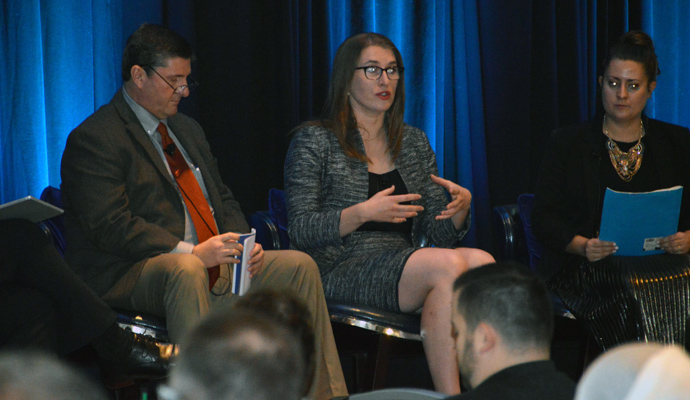Data, Clinical Champions Key to Risk-Based Payment Model Success
Internal and external data and having clinical champions to enact changes are critical to moving forward with risk-based payment models, say experts at the Value-Based Care Summit.

Source: Getty Images
- Healthcare spending is unsustainable and risk-based payment models are one of the ways to address that problem.
Neither of these concepts are new to the healthcare community and have been around for decades. But there is a new urgency around risk-based payment adoption and these models are coming for providers whether they want them or not, Theresa Dreyer, MPH, lead of value-based care at the Association of American Medical Colleges (AAMC) stressed at Xtelligent Healthcare Media’s Value-Based Care Summit in Boston this October.
During a panel discussion, Dreyer, who provides policy analysis, data analytics, and advocacy to over 40 teaching hospitals as they implement Medicare bundled payment programs, emphasized the role downside risk will play in the future of healthcare.
Risk-payment payment models will drive clinical change, which is a major financial opportunity, she explained. By having dollars on the line, healthcare organizations of all sizes will alter the way their providers practice medicine in order to reduce costs while improving patient outcomes.
And case studies have proven her right. A recent analysis of healthcare costs in California found that total costs of care were 3.5 percent lower when providers participated in risk-based payment models, and the providers scored higher on clinical quality performance measures compared to providers in fee-for-service arrangements.
READ MORE: Reimbursement Adequacy, Timely Data Needed for Risk-Based Payment
In Boston, Atrius Health also reported ending 2018 with a $38.7 million operating surplus after tying three-quarters of its revenues to risk-based payment models. The medical group was also in the 90th percentile for most of the quality measures in their contracts.
However, healthcare organizations are still largely risk-averse. The median percentage of revenue in payment models with either upside or downside risk has remained at about ten percent for the last three years, consulting firm Numerof & Associates reported earlier this year. Furthermore, almost one-third of the respondents participating in a model with some level of financial risk said their agreements had no downside risk.
Policymakers are pushing providers – especially those in the hospital setting – to assume downside risk or face lower reimbursement rates and greater administrative burden. CMS is even looking to implement mandatory risk-based payment models in some regions.
With the healthcare community on a fast track to risk adoption, Darrin D. Menard, MD, FAAFP, a family physician and local medical director for Aledade Louisiana and Southeast ACO, advised providers to look at their data.

Source: Kelsey Waddill
Data, analytics are the foundation of risk success
Data is key to risk-based payment model success at Menard’s practice, which just recently decided to assume downside financial through an ACO with Aledade.
READ MORE: Exploring Two-Sided Financial Risk in Alternative Payment Models
“In my independent primary care practice, the data is the key component that allows us to make changes across our entire population of patients, not just one patient at a time,” he said during the panel discussion. That population health data has enabled the practice to get the right patients in at the right time to make the most educated decisions that impact outcomes.
His practice also decided to assume downside risk after gaining access from local hospitals on a timely basis.
“The most important thing for me is getting automatic data feeds to our offices to make sure the patients are getting discharged, so that we can get that transition of care into our office as soon as possible. We want to make sure that those patients are getting taken care of from the minute that they leave the hospital.”
Accessing internal and external data is critical to participating in risk-based payment models, agreed Timothy Mills, chief growth officer at Alpha II, a health IT company offering coding, compliance, revenue analysis, and claim/encounter editing technology for healthcare professionals, clearinghouses, and government entities.
“We're beginning to see more vendors look beyond themselves and their technology to work toward building more longitudinal records that can become EMR agnostic or system agnostic,” he said. “Being able to not only get access to data across all those different scenarios, but being able to access both claims data and clinical data and even beyond that to turn it into some usable information.”
READ MORE: How Downside Risk Will Impact Participation in Pathways to Success
Accessing that data and gleaning actionable insights has been a challenge, Menard admitted. The family physician does not have experience with deciphering large amounts of data and distributing the information to everyone else. That is where teamwork and clinical champions come in.

Source: Kelsey Waddill
Clinical champions critical to moving forward with risk
As a convener for Medicare’s Bundled Payments for Care Improvement (BPCI) Advanced, AAMC does not let hospitals pass go without having a clinical champion to spearhead risk-based payment model participation.
“In some ways, we can almost predict an organization's success as to whether they have physicians in the room or whether we're only talking to analysts,” Dreyer said. “It doesn't matter how good your target is. If you can't get the clinical change that is going to come from having that physician involved, it will be very hard to succeed in that bundle.”
That rings true for physician practices, too.
“Essentially, the practices that are very successful have the drive of the physician in the clinic that makes the changes that need to happen because honestly the staff is going to listen to that person the most because that person has hired them,” Menard said. “Once that trust is built, then they're open to hearing how to make change in other areas.”
Developing trust among staff and the risk-based payment model is also key to success, Menard added.
“So, when we get down to the downside risk question in all these practices, it's based on the trust that they've associated with the ACO and with their own team,” he highlighted.
“The most important thing if you're going to dive in, is it's really hard to coast into success under a risk-based arrangement,” Dreyer concluded. “Very few models are going to have targets that are easy wins so you can just keep-on-keeping-on and make some money. So, if you need to make clinical change, you have to have your clinicians at the table, you need a designated champion, and that person needs to specialize in the type of care you're trying to transform. That would be the starting place for any risk-based arrangement you want to start.”
Join us in Austin June 3-5, 2020 for the Value-Based Care Summit & Telehealth20!
